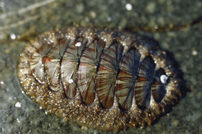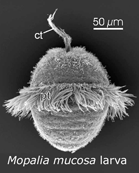 In early online 12 Jan 2007 Mol Ecol Notes researchers from Columbia University, American Museum of Natural History, and California State University analyze COI barcode region sequences of 131 individuals representing 19 species of Mopalia chitons. Chitons are molluscs with flattened segmented shells, and most of the 860 known world species are herbivores that graze in tidal zones, although some are found at depths up to 6000 meters. According to the authors “much of the biology of [Mopalia sp] remains undiscovered” because many “are difficult to distinguish from one another by morphology alone”, making them a good test case for DNA barcoding.
In early online 12 Jan 2007 Mol Ecol Notes researchers from Columbia University, American Museum of Natural History, and California State University analyze COI barcode region sequences of 131 individuals representing 19 species of Mopalia chitons. Chitons are molluscs with flattened segmented shells, and most of the 860 known world species are herbivores that graze in tidal zones, although some are found at depths up to 6000 meters. According to the authors “much of the biology of [Mopalia sp] remains undiscovered” because many “are difficult to distinguish from one another by morphology alone”, making them a good test case for DNA barcoding.
Kelly et al compared three approaches for identifying Mopalia chitons by COI. First, they used a “character based assessment called characteristic attribute organization system (CAOS)”. In this approach, a “guide tree” is generated using maximum likelihood or parsimony, and CAOS identifies sets of characters for each node in the guide tree. CAOS then attempts to assign unknowns based on these characters. If there is insufficient information  to assign the query sequence, CAOS stops the analysis. The authors compared CAOS to neighbor-joining distance analysis on Barcode of Life Data Systems (BOLD) site, and to BLAST algorithm. All three approaches had overall accuracy of 100% when provided with the entire data set. CAOS was superior to NJ and BLAST when a skeletonized reference set containing of 50% of the total sequences was used.
to assign the query sequence, CAOS stops the analysis. The authors compared CAOS to neighbor-joining distance analysis on Barcode of Life Data Systems (BOLD) site, and to BLAST algorithm. All three approaches had overall accuracy of 100% when provided with the entire data set. CAOS was superior to NJ and BLAST when a skeletonized reference set containing of 50% of the total sequences was used.
CAOS automatically identifies diagnostic molecular characters, and this will help integrate DNA barcode data into traditional taxonomy. For practical use, diagnostic sequence differences may aid design of solid-state microarrays that detect species in environmental samples, such as the 0.1mm Mopalia mucosa planktonic larva shown here, which might be found floating in seawater, or in the stomach of a krill.